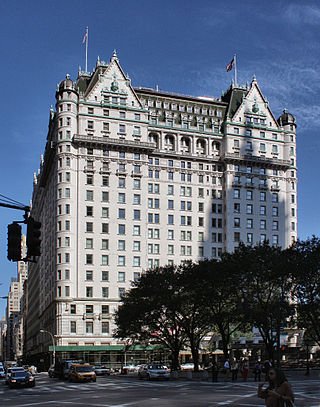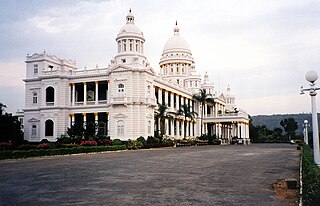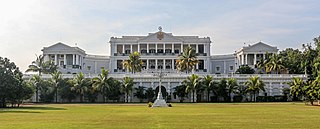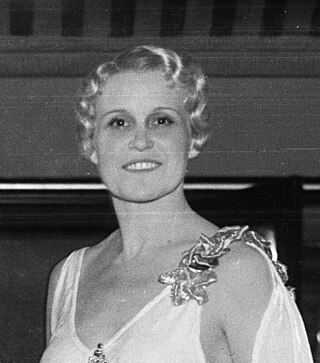
The Arizona Biltmore is a historic resort located in Phoenix near 24th Street and Camelback Road. Designed by Albert Chase McArthur, it opened on February 23, 1929, as part of the Biltmore Hotel chain. Actors Clark Gable and Carole Lombard often stayed there and the Tequila sunrise cocktail was invented there. It is part of LXR Hotels & Resorts.

The Waldorf Astoria New York is a luxury hotel and condominium residence in Midtown Manhattan in New York City. The structure, at 301 Park Avenue between 49th and 50th Streets, is a 47-story 625 ft (191 m) Art Deco landmark designed by architects Schultze and Weaver and completed in 1931. The building was the world's tallest hotel until 1957, when it was surpassed by Moscow's Hotel Ukraina. An icon of glamor and luxury, the Waldorf Astoria is one of the world's most prestigious and best-known hotels. Once owned by Conrad Hilton, Waldorf Astoria Hotels & Resorts, a division of Hilton Hotels, operates under the name of the original hotel in locations around the world. Both the exterior and the interior of the New York's Waldorf Astoria are designated by the New York City Landmarks Preservation Commission as official landmarks.

Biltmore Estate is a historic house museum and tourist attraction in Asheville, North Carolina. Biltmore House, the main residence, is a Châteauesque-style mansion built for George Washington Vanderbilt II between 1889 and 1895 and is the largest privately owned house in the United States, at 178,926 sq ft (16,622.8 m2) of floor space and 135,280 sq ft (12,568 m2) of living area. Still owned by George Vanderbilt's descendants, it remains one of the most prominent examples of Gilded Age mansions.

Ca' Rezzonico is a palazzo and art museum on the Grand Canal in the Dorsoduro sestiere of Venice, Italy. It is a particularly notable example of the 18th century Venetian baroque and rococo architecture and interior decoration, and displays paintings by the leading Venetian painters of the period, including Francesco Guardi and Giambattista Tiepolo. It is a public museum dedicated to 18th-century Venice and one of the 11 venues managed by the Fondazione Musei Civici di Venezia.

The Plaza Hotel is a luxury hotel and condominium apartment building in Midtown Manhattan in New York City. It is located on the western side of Grand Army Plaza, after which it is named, just west of Fifth Avenue, and is between 58th Street and Central Park South, at the southeastern corner of Central Park. Its primary address is 768 Fifth Avenue, though the residential entrance is One Central Park South. Since 2018, the hotel has been owned by the Qatari firm Katara Hospitality.

The Mayflower Hotel is a historic hotel in downtown Washington, D.C., located on Connecticut Avenue NW. It is two blocks north of Farragut Square and one block north of the Farragut North Metro station. The hotel is managed by Autograph Collection Hotels, a division of Marriott International.

The New York Biltmore Hotel was a luxury hotel at 335 Madison Avenue in Midtown Manhattan, New York City. The hotel was developed by the New York Central Railroad and the New York, New Haven and Hartford Railroad and operated from 1913 to 1981. It was one of several large hotels developed around Grand Central Terminal as part of Terminal City. The Biltmore was designed in the Italian Renaissance Revival style by Warren and Wetmore, one of the firms involved in designing Grand Central. Although the hotel's steel frame still exists, the hotel itself was almost entirely demolished and replaced by an office building in the early 1980s.

The Lalitha Mahal, now renamed Lalitha Mahal Palace Hotel, is a luxury hotel located in a former royal residence, and the second largest palace in the southern Indian city of Mysore, Karnataka, after the Mysore Palace. It is located near the Chamundi Hills, east of the city. The palace was built in 1921 by Maharaja Krishnaraja Wodeyar IV for the exclusive stay of the Governor-General of India.

Hotel Astor was a hotel on Times Square in the Midtown Manhattan neighborhood of New York City, United States. Built in 1905 and expanded in 1909–1910 for the Astor family, the hotel occupied a site bounded by Broadway, Shubert Alley, and 44th and 45th Streets. Architects Clinton & Russell designed the hotel as an 11-story Beaux-Arts edifice with a mansard roof. It contained 1,000 guest rooms, with two more levels underground for its extensive "backstage" functions, such as the wine cellar.
Schultze & Weaver was an architecture firm established in New York City in 1921. The partners were Leonard Schultze and S. Fullerton Weaver.

Falaknuma is a palace in Hyderabad, Telangana, India. It originally belonged to the Paigah family, and was later owned by the Nizam of Hyderabad. It is on a hillock and covers a 13-hectare (32-acre) area in Falaknuma, 5 kilometres (3.1 mi) from Charminar.

InterContinental Chicago Magnificent Mile is a hotel in Chicago, United States. The hotel currently occupies two multi-story buildings. The historic tower, or "South Tower," is a 471-foot (144 m), 42-story building which was completed in 1929 originally as the home of the Medinah Athletic Club. The new tower, or "North Tower" is a 295-foot (90 m), 26-story addition, completed in 1961.

Flintridge Sacred Heart Academy is a private, all-girls Catholic high school in the Roman Catholic Archdiocese of Los Angeles run by the Dominican Sisters of Mission San Jose. It is located in La Cañada Flintridge, California, on a 41 acres (170,000 m2) campus near the San Gabriel Mountains.

Crystal Ballroom, originally built as Cotillion Hall, is a historic building on Burnside Street in Portland, Oregon, United States. Cotillion Hall was built in 1914 as a ballroom, and dance revivals were held there through the Great Depression. Starting in the 1960s, the hall has also been host to many popular pop, rock, folk, blues and jazz artists, as well as beat poetry and other entertainment.

The Palm Court, also known at other times as the Franco-Italian Dining Room, the Grand Ballroom and the Continental Room, is a ballroom at the Hotel Alexandria in downtown Los Angeles, California. In its heyday from 1911 to 1922, it was the scene of speeches by U.S. Presidents William Howard Taft and Woodrow Wilson and Gen. John J. Pershing. It is also the room where Paul Whiteman, later known as the "Jazz King", got his start as a bandleader in 1919, where Rudolph Valentino danced with movie starlets, and where Hollywood held its most significant balls during the early days of the motion picture business. Known for its history and its stained-glass Tiffany skylight, noted Los Angeles columnist Jack Smith called it "surely the most beautiful room in Los Angeles". The Palm Court was designated as a City of Los Angeles Historic-Cultural Monument (HCM#80) in 1971.

The Mrs. William B. Astor House was a mansion on the Upper East Side of Manhattan, New York City, at 840-841 Fifth Avenue on the northeast corner of 65th Street, completed in 1896 and demolished around 1926.

The Hollywood Roosevelt Hotel is a historic hotel located at 7000 Hollywood Boulevard in the Hollywood district of Los Angeles, California. It opened on May 15, 1927, and is the oldest continually operating hotel in Los Angeles.

The Hotel Alexandria is a historic building constructed as a luxury hotel at the beginning of the 20th century in what was then the heart of downtown Los Angeles. As the business center of the city moved gradually westward, the hotel decayed and gradually devolved into a single-room occupancy (SRO) hotel housing long-term, low income residents and gained a reputation for crime and being unsafe. Revitalization of the area in the 21st century changed the rental practices and neighborhood safety.

Peggy Hamilton was an American fashion and costume designer who designed many dresses for Hollywood silent actresses in the 1920s and 1930s. She was also the editor of a fashion column in The Los Angeles Times and a fashion commentator on the radio. She was "one of the first boosters of Los Angeles-made fashions."
John B. Smeraldi was an Italian-born American muralist, and furniture and interior designer. He painted the ceilings of many buildings, including the ballroom inside the Biltmore Hotel in Los Angeles, California.





















